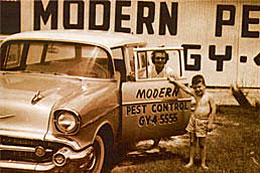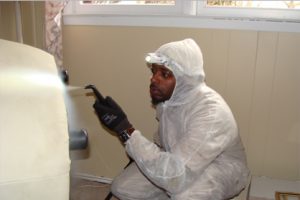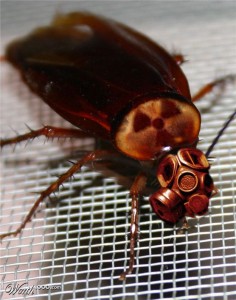 Years ago my service manager made a statement to a customer that still sticks with me to this day. It was a roach complaint and from my ‘newbie’ perspective she had a lot to complain about. Roaches were everywhere and it seemed as if we hadn’t sprayed at all even though we were just there a few days earlier.
Years ago my service manager made a statement to a customer that still sticks with me to this day. It was a roach complaint and from my ‘newbie’ perspective she had a lot to complain about. Roaches were everywhere and it seemed as if we hadn’t sprayed at all even though we were just there a few days earlier.
He said
“it takes about a half an hour of sitting in the dried material for the roach to absorb enough to die, It’s not a nuclear bomb.”
Of course he went on to explain the process of our treatment in greater detail and assured her that with a little time her problem would subside and the roaches would all eventually die. He also pulled out some appliances and showed her the hundreds of dead roaches that she otherwise wouldn’t have seen. He was a really good manager and I learned a lot from him during my training.
Now with today’s products and new application tools you would think we’ve surpassed the old technology of the 80’s. Surely a pest control professional in the 21st century could wipe out an infestation of German cockroaches with just a few sprit’s of this and a couple of dab’s of that. It shouldn’t take any time whatsoever to rid any unwanted pest from anyone’s home. Not hardly.
In today’s ‘politically correct’ world we really have lost some tools that gave us such a devastating  blow to insect colonies. In times past you could simply put your B&G sprayer on fan spray and wipe out all sorts of bugs right in front of your eyes. A lot of those were being phased out just as I was getting into the industry and the newer ‘safer’ products were a lot slower in their knockdown power. We used things like a drop of soap in the tank mix to help adjuvant the chemical but nothing really matched what we had previously. Aerosols were still relatively untouched at the time but soon key ingredients that used to send the bug into a tizzy were being replaced and a much more ‘moderate’ effect was all we could muster.
blow to insect colonies. In times past you could simply put your B&G sprayer on fan spray and wipe out all sorts of bugs right in front of your eyes. A lot of those were being phased out just as I was getting into the industry and the newer ‘safer’ products were a lot slower in their knockdown power. We used things like a drop of soap in the tank mix to help adjuvant the chemical but nothing really matched what we had previously. Aerosols were still relatively untouched at the time but soon key ingredients that used to send the bug into a tizzy were being replaced and a much more ‘moderate’ effect was all we could muster.
No other part of the industry was hit harder I’d say than termite treatments with roaches and ants a close second. Even with chlordane we would get tons of complaints every year of swarmer termites in the same spot they had been last year and the year before. Now with Dursban as the replacement we got even more and when that was taken off the market it seemed that all was lost and the termites had won. I know of a man in my town that has done termite work for 35 years at the time who simply stopped renewing any termite work and walked away from that end of the business.
 Still it seems that history has begun to repeat itself somewhat in the pest control world. Our products now may not have the instant knock down as in the past but with some; it’s only a matter of hours before 100’s of thousands of ants, termites or the like crash with 100% mortality rates. Baits for roaches not only kill the first time through a roach’s gut but the 2nd, 3rd, 4th and so on down the line as others eat the waste of the first or the dead body and thus get their lethal dose. What used to rely on the thoroughness of the technicians ‘good spray coverage’ now simply uses the insects habit patterns to spread the material into the places that not even the smallest applicator could reach.
Still it seems that history has begun to repeat itself somewhat in the pest control world. Our products now may not have the instant knock down as in the past but with some; it’s only a matter of hours before 100’s of thousands of ants, termites or the like crash with 100% mortality rates. Baits for roaches not only kill the first time through a roach’s gut but the 2nd, 3rd, 4th and so on down the line as others eat the waste of the first or the dead body and thus get their lethal dose. What used to rely on the thoroughness of the technicians ‘good spray coverage’ now simply uses the insects habit patterns to spread the material into the places that not even the smallest applicator could reach.
Even with all these great advancements it seems at least on the outward appearance that nothing has changed. It still can take months to rid a home of German roach’s and we still get a few termite retreats albeit very few. In today’s service we no longer rely on the broad application of the chemical but the pin point treatment to areas that we know the insects are or will be. We’ve replaced ounces  and gallons with grams and syringe sized dots in our war with these 350 million year old foes.
and gallons with grams and syringe sized dots in our war with these 350 million year old foes.
As if in a flashback I stand in front of a customer and basically drown a roach at the base of the cabinet and we both stare in amazement as he scratches and claws his way out of the puddle and seeks a crack nearby to dry off and ‘lives to see another day.‘ I think back to how my manager handled things over 25 years ago and begin my explanation to the client as to what she can expect. I still explain that it takes time for the roach to die but I’ve added my own wrinkle to his words that maybe someday a technician that I’ve trained will use when he is on his own too.
“Sure, I exclaim, he may have escaped for now, just think of him as a ‘dead bug walking’ but he needs to do some work for me first.”




